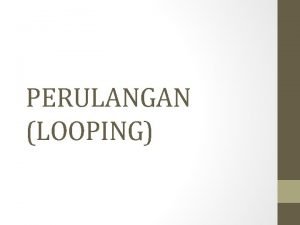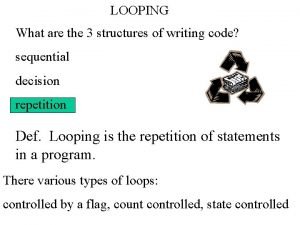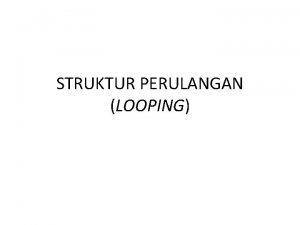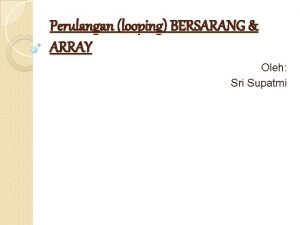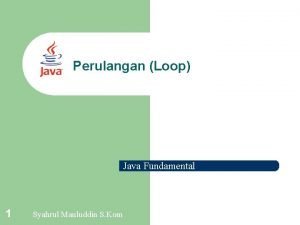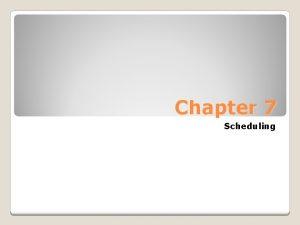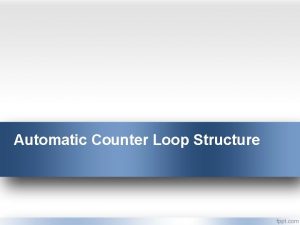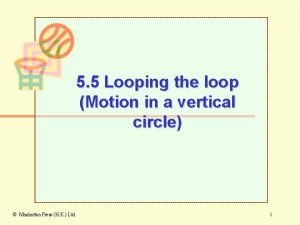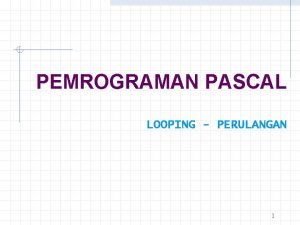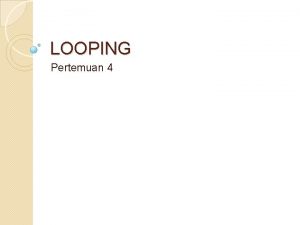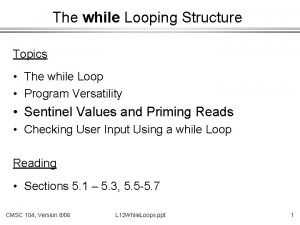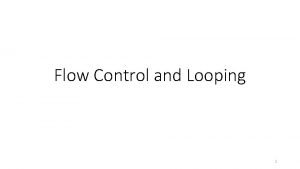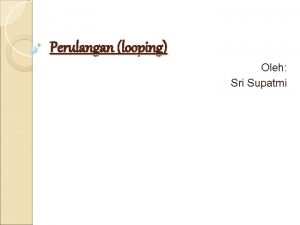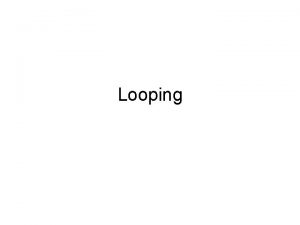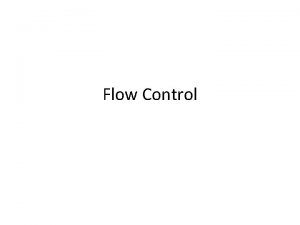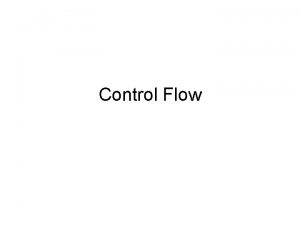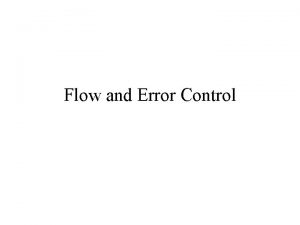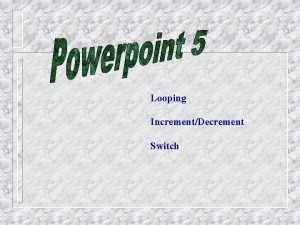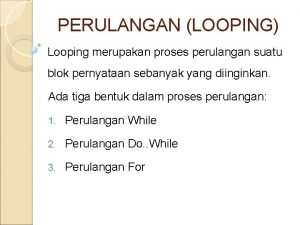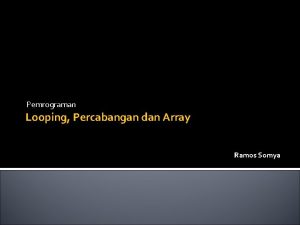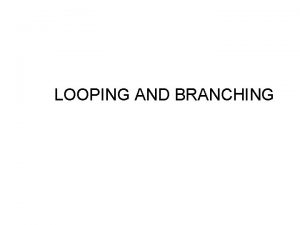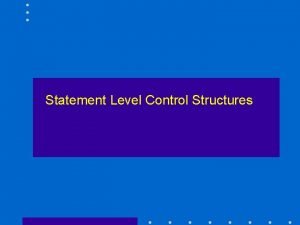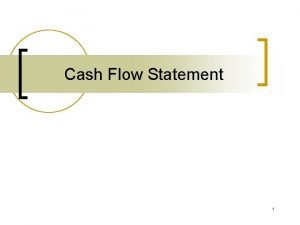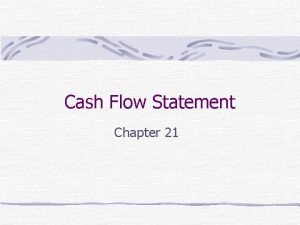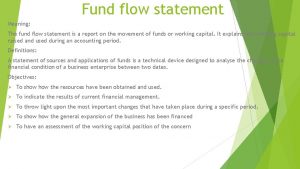Outline Control Flow Statements Looping statement for statements





![? : 運算子 public class Compare { public static void main (String[] args) { ? : 運算子 public class Compare { public static void main (String[] args) {](https://slidetodoc.com/presentation_image_h/2addc6d91f3576d4ee7b67cdb3971c4a/image-6.jpg)




















![方法(Method) 定義 可重複使用的程式碼片段 範例:public static void main (String[] args); 格式 存取範圍 方法特性 public protected 方法(Method) 定義 可重複使用的程式碼片段 範例:public static void main (String[] args); 格式 存取範圍 方法特性 public protected](https://slidetodoc.com/presentation_image_h/2addc6d91f3576d4ee7b67cdb3971c4a/image-27.jpg)







![參數傳遞(Passing Argument) Example: Pass. Arg. Demo. java static void my. Method 2 (int[] i) 參數傳遞(Passing Argument) Example: Pass. Arg. Demo. java static void my. Method 2 (int[] i)](https://slidetodoc.com/presentation_image_h/2addc6d91f3576d4ee7b67cdb3971c4a/image-35.jpg)
![參數傳遞(Passing Argument) Memory i i[0] i 0 x 5678 0 x 1234 10 0 參數傳遞(Passing Argument) Memory i i[0] i 0 x 5678 0 x 1234 10 0](https://slidetodoc.com/presentation_image_h/2addc6d91f3576d4ee7b67cdb3971c4a/image-36.jpg)



- Slides: 39


Outline Control Flow Statements Looping statement • for statements • while/do-while statements Branching statement • break, continue, label: and return Your Turn 方法(Methods) 參數 傳值 傳址 傳回值 Your Turn (Arguments) (Pass-by-Value) (Pass-by-Reference) (return)

Control Flow Statements

Control Flow Statements – if-else 較複雜的情況,我們會 使用巢狀 if-else 敘述 if (expression) { BODY 1 if(expression) { BODY 1 a } else { BODY 1 b } else { BODY 2 }

Decision; Condition if (a>b) { max = a; min = b; } else { min = a; max = b; } if (c>max) { max = c; } if (c<min) { min = c; }
![運算子 public class Compare public static void main String args ? : 運算子 public class Compare { public static void main (String[] args) {](https://slidetodoc.com/presentation_image_h/2addc6d91f3576d4ee7b67cdb3971c4a/image-6.jpg)
? : 運算子 public class Compare { public static void main (String[] args) { int x = Integer. parse. Int(args[0]); int y = Integer. parse. Int(args[1]); int z = Integer. parse. Int(args[2]); int max, min; max =x > y ? x : y; min =x < y ? x : y; max =z > max ? z : max; min =z < max ? z : min; System. out. println("Max: "+max+", Min: "+min); } }

Control Flow Statements – switch-case switch statement expression的數值,將會被拿來 比對下面每一個case的value 程式將會跳至第一個比對成功( 數值相等)的地方繼續執行,假 如遇到break; 敘述,就結束整個 switch敘述 否則將會一直往下比對。沒有比 對成功的話,則執行default: 之後 的程式段 • 沒遇到break時,會繼續執行下一行 指令敘述 switch(expression) { case value 1: statements… break; case value 2: statements… break; … default: statements… break; }

Control Flow Statements Looping 將一段程式,重複執行數次,我們稱這段重複執行的程 式為迴圈。 Java looping statement 的種類: for while do-while

Control Flow Statements – for statement 語法 for( initialization; termination; increment ) { statements… } initialization:初始條件 • 在此宣告之變數其有效範圍僅存在於此迴圈內 • 例:for(int x=0; x<10; x++) { … } termination:終止條件,決定何時迴圈結束 increment:遞增,每次迴圈進行後所要做的事

Control Flow Statements – for Example: For. Example. java /** * 在螢幕上印出 1 ~ 10 */ for (int i=1; i <=10; i++) { System. out. println ("i = " + i); }

Control Flow Statements – for Example: For. Example. java /** * 印出 1~10, 最後在印出最後的 i 值 */ int i; for (i=1; i <=10; i++) System. out. println ("i = " + i); System. out. println ("After loop, i = " + i);


Control Flow Statements – for Example: For. Example. java /** * 一個迴圈內,可以有多個控制變數 */ int max. X = 10; int max. Y = 15; for (int x = 0, y = 0; (x < max. X) && (y < max. Y); x++, y = x * 2) { System. out. println(" x < 10 : " + x + ", y < 15 : " + y); }

Control Flow Statements – for Example: For. Example. java /** * 巢狀迴圈的使用方法 */ for (int i=1; i <=10; i++) { for (int j=1; j <=10; j++) { for (int k=1; k <=10; k++) { System. out. println("i = " + i + " j = " + j + " k = " + k); } // end of for k } // end of for j } // ned of for i


Control Flow Statements – while/do-while Example: While. Example. java public class While. Example { public static void main(String[] args) { double r = 0; while(r < 0. 99 d) { r = Math. random(); // Math 類別中提供產生亂數的類別方法 System. out. println(r); } // end of while } }


Control Flow Statements – while/do-while Example: Do. While. Example. java /** * 計算所有平方值小於 100 的數字並印出 */ public class Do. While. Example { public static void main (String[] args) { int i=0, j; do { i++; j = i * i; System. out. println ( i + " * " + i + " = " + j); } while (j < 100); } }


Control Flow Statements – branching Exmaple: Break. And. Continue. java for(int i = 0; i < 100; i++) { if(i == 74) break; // Out of for loop if(i % 9 != 0) continue; // Next iteration System. out. println(i); }


Control Flow Statements – branching break with label search: for ( ; i < array. Of. Ints. length; i++) { for (j = 0; j < array. Of. Ints[i]. length; j++) { if (array. Of. Ints[i][j] == searchfor) { found. It = true; break search; } } }

Control Flow Statements – branching continue with label test: for (int i = 0; i <= max; i++) { int n = substring. length(); while (n-- != 0) { if (n == 1) continue test; System. out. println(“no move!!!”); } //end of while found. It = true; break test; } // end of for i



![方法Method 定義 可重複使用的程式碼片段 範例public static void main String args 格式 存取範圍 方法特性 public protected 方法(Method) 定義 可重複使用的程式碼片段 範例:public static void main (String[] args); 格式 存取範圍 方法特性 public protected](https://slidetodoc.com/presentation_image_h/2addc6d91f3576d4ee7b67cdb3971c4a/image-27.jpg)
方法(Method) 定義 可重複使用的程式碼片段 範例:public static void main (String[] args); 格式 存取範圍 方法特性 public protected (空白) private static final abstract native synchronized 方法傳回型態 方法名稱 (參數宣告);


方法(Method) 定義 methods public Object push (Object item) 存取等級 method 本身的存取等級 static 宣告本 method 為 class method abstract 宣告本 method 內不需任何程式碼 final 宣告本 method 不允許被 subclass 覆蓋(override) native 宣告本 method 為其他程式語言所寫成 synchronized 必須由 monitor 來控制執行時機 (參數列) 參數列 throws 異常事件 宣告本 method 丟出的例外(exceptions)



方法(Method) Example: Method. Demo. java static void print. Triangle(int level) { int i, j; for ( i = 1; i <= level; i++) { for ( j = 1; j <= i; j++ ) System. out. print("*"); System. out. println(); } }


參數傳遞(Passing Argument) Example: Pass. Arg. Demo. java static void my. Method 1 (int i) { i += 1; System. out. println("In My. Method(): " + i); } public static void main(String[] args) { int i = 10; // 參數以 primitive 的型態傳入 my. Method(i); // 不會改變在 main 中的 i 值 System. out. println("In main(): " + i); }
![參數傳遞Passing Argument Example Pass Arg Demo java static void my Method 2 int i 參數傳遞(Passing Argument) Example: Pass. Arg. Demo. java static void my. Method 2 (int[] i)](https://slidetodoc.com/presentation_image_h/2addc6d91f3576d4ee7b67cdb3971c4a/image-35.jpg)
參數傳遞(Passing Argument) Example: Pass. Arg. Demo. java static void my. Method 2 (int[] i) { i[0] = i[0] +1; System. out. println("In My. Func(): " + i[0]); } public static void main(String[] args) { int[] i = {10}; my. Method 2(i); System. out. println("In main(): " + i[0]); }
![參數傳遞Passing Argument Memory i i0 i 0 x 5678 0 x 1234 10 0 參數傳遞(Passing Argument) Memory i i[0] i 0 x 5678 0 x 1234 10 0](https://slidetodoc.com/presentation_image_h/2addc6d91f3576d4ee7b67cdb3971c4a/image-36.jpg)
參數傳遞(Passing Argument) Memory i i[0] i 0 x 5678 0 x 1234 10 0 x 5678 0 x 9012 public static void main(String[] args) static void My. Func(int[] i)


從 method 回傳數值(return) Example: Pass. Arg. Demo. java static int my. Method 3 (int i) { i *= 10; return i; } public static void main(String[] args) { int i = 10; int j = my. Method 3(i); System. out. println("The return value: " + j); }

Your Turn 試寫二個 static method 方法: static void print. Add 2 N(int max) static int get. Add 2 N(int max) 方別傳入一個參數 max,可以計算從 1 加到 max 的運算 最後再寫一個 main() 來測試 如: 1+2+3+4+5+6+7+8+9+10 = 55 Result: 55
 Looping statement in qbasic
Looping statement in qbasic Data flow vs control flow
Data flow vs control flow Control flow and data flow computers
Control flow and data flow computers Control flow vs transaction flow
Control flow vs transaction flow Stock control e flow control
Stock control e flow control Flow control and error control
Flow control and error control Citation sandwich example
Citation sandwich example Struktur looping adalah
Struktur looping adalah Array
Array Looping in writing
Looping in writing Bentuk umum statement for
Bentuk umum statement for Nested array
Nested array Looping bersarang java
Looping bersarang java Disadvantages of looping in education
Disadvantages of looping in education Counter-controlled
Counter-controlled Dangling in network diagram
Dangling in network diagram Automatic counter loop
Automatic counter loop Effects of looping the loop in circular motion
Effects of looping the loop in circular motion Struktur algoritma pengulangan
Struktur algoritma pengulangan Looping pemrograman
Looping pemrograman For to do pascal
For to do pascal Small basic turtle commands
Small basic turtle commands Loop logic programming
Loop logic programming Branching flowchart
Branching flowchart Looping
Looping Apple core
Apple core Slidetodoc
Slidetodoc Looping iv tubing
Looping iv tubing Perulangan looping
Perulangan looping Nested loops python
Nested loops python Perulangan looping
Perulangan looping Fspos vägledning för kontinuitetshantering
Fspos vägledning för kontinuitetshantering Novell typiska drag
Novell typiska drag Tack för att ni lyssnade bild
Tack för att ni lyssnade bild Returpilarna
Returpilarna Shingelfrisyren
Shingelfrisyren En lathund för arbete med kontinuitetshantering
En lathund för arbete med kontinuitetshantering Adressändring ideell förening
Adressändring ideell förening Personlig tidbok för yrkesförare
Personlig tidbok för yrkesförare Sura för anatom
Sura för anatom







